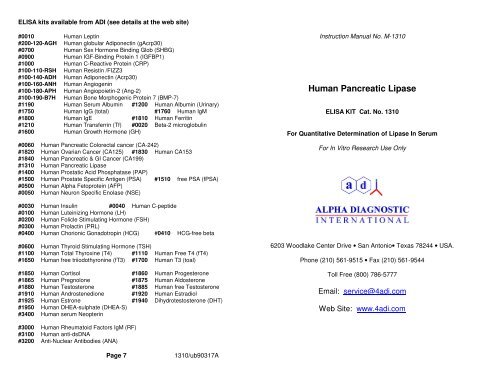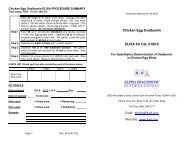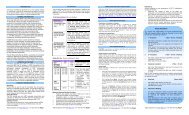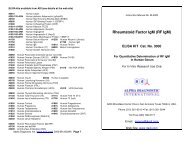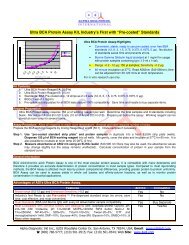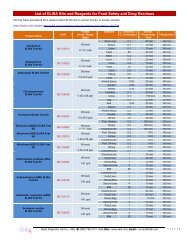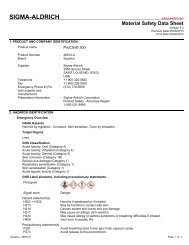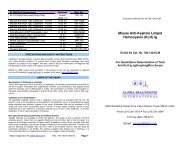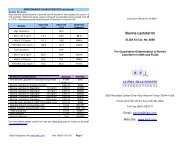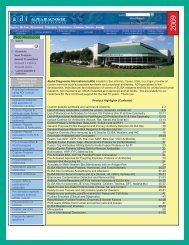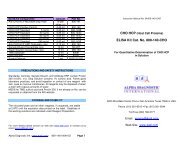Human Pancreatic Lipase
Human Pancreatic Lipase
Human Pancreatic Lipase
You also want an ePaper? Increase the reach of your titles
YUMPU automatically turns print PDFs into web optimized ePapers that Google loves.
ELISA kits available from ADI (see details at the web site)#0010 <strong>Human</strong> Leptin#200-120-AGH <strong>Human</strong> globular Adiponectin (gAcrp30)#0700 <strong>Human</strong> Sex Hormone Binding Glob (SHBG)#0900 <strong>Human</strong> IGF-Binding Protein 1 (IGFBP1)#1000 <strong>Human</strong> C-Reactive Protein (CRP)#100-110-RSH <strong>Human</strong> Resistin /FIZZ3#100-140-ADH <strong>Human</strong> Adiponectin (Acrp30)#100-160-ANH <strong>Human</strong> Angiogenin#100-180-APH <strong>Human</strong> Angiopoietin-2 (Ang-2)#100-190-B7H <strong>Human</strong> Bone Morphogenic Protein 7 (BMP-7)#1190 <strong>Human</strong> Serum Albumin #1200 <strong>Human</strong> Albumin (Urinary)#1750 <strong>Human</strong> IgG (total) #1760 <strong>Human</strong> IgM#1800 <strong>Human</strong> IgE #1810 <strong>Human</strong> Ferritin#1210 <strong>Human</strong> Transferrin (Tf) #0020 Beta-2 microglobulin#1600 <strong>Human</strong> Growth Hormone (GH)#0060 <strong>Human</strong> <strong>Pancreatic</strong> Colorectal cancer (CA-242)#1820 <strong>Human</strong> Ovarian Cancer (CA125) #1830 <strong>Human</strong> CA153#1840 <strong>Human</strong> <strong>Pancreatic</strong> & GI Cancer (CA199)#1310 <strong>Human</strong> <strong>Pancreatic</strong> <strong>Lipase</strong>#1400 <strong>Human</strong> Prostatic Acid Phosphatase (PAP)#1500 <strong>Human</strong> Prostate Specific Antigen (PSA) #1510 free PSA (fPSA)#0500 <strong>Human</strong> Alpha Fetoprotein (AFP)#0050 <strong>Human</strong> Neuron Specific Enolase (NSE)Instruction Manual No. M-1310<strong>Human</strong> <strong>Pancreatic</strong> <strong>Lipase</strong>ELISA KIT Cat. No. 1310For Quantitative Determination of <strong>Lipase</strong> In SerumFor In Vitro Research Use Only#0030 <strong>Human</strong> Insulin #0040 <strong>Human</strong> C-peptide#0100 <strong>Human</strong> Luteinizing Hormone (LH)#0200 <strong>Human</strong> Folicle Stimulating Hormone (FSH)#0300 <strong>Human</strong> Prolactin (PRL)#0400 <strong>Human</strong> Chorionic Gonadotropin (HCG) #0410 HCG-free beta#0600 <strong>Human</strong> Thyroid Stimulating Hormone (TSH)#1100 <strong>Human</strong> Total Thyroxine (T4) #1110 <strong>Human</strong> Free T4 (fT4)#1650 <strong>Human</strong> free triiodothyronine (fT3) #1700 <strong>Human</strong> T3 (toal)#1850 <strong>Human</strong> Cortisol #1860 <strong>Human</strong> Progesterone#1865 <strong>Human</strong> Pregnolone #1875 <strong>Human</strong> Aldosterone#1880 <strong>Human</strong> Testosterone #1885 <strong>Human</strong> free Testosterone#1910 <strong>Human</strong> Androstenedione #1920 <strong>Human</strong> Estradiol#1925 <strong>Human</strong> Estrone #1940 Dihydrotestosterone (DHT)#1950 <strong>Human</strong> DHEA-sulphate (DHEA-S)#3400 <strong>Human</strong> serum Neopterin6203 Woodlake Center Drive • San Antonio• Texas 78244 • USA.Phone (210) 561-9515 • Fax (210) 561-9544Toll Free (800) 786-5777Email: service@4adi.comWeb Site: www.4adi.com#3000 <strong>Human</strong> Rheumatoid Factors IgM (RF)#3100 <strong>Human</strong> anti-dsDNA#3200 Anti-Nuclear Antibodies (ANA)Page 7 1310/ub90317A
<strong>Pancreatic</strong> <strong>Lipase</strong> ELISA Kit Cat. No. 1310For Quantitative Determination of <strong>Pancreatic</strong> <strong>Lipase</strong> In SerumKit Contents: (reagents for 96 tests)C o m p o n e n t s C a t . N o .Anti-h pancreatic <strong>Lipase</strong> coated microwell 1 3 1 1strip plate (96 wells). Ready-to-use<strong>Pancreatic</strong> <strong>Lipase</strong> Sample Diluent or1 3 1 2Std. A (0 U/L), 11 ml<strong>Pancreatic</strong> <strong>Lipase</strong> Std. B, 0.75 ml (10 U/L) 1 3 1 3<strong>Pancreatic</strong> <strong>Lipase</strong> Std. C, 0.75 ml (50 U/L) 1 3 1 4<strong>Pancreatic</strong> <strong>Lipase</strong> Std. D, 0.75 ml (100 U/L) 1 3 1 5<strong>Pancreatic</strong> <strong>Lipase</strong> Std. E, 0.75 ml (200 U/L) 1 3 1 6<strong>Pancreatic</strong> <strong>Lipase</strong> Std. F, 0.75 ml (400 U/L) 1 3 1 7<strong>Pancreatic</strong> <strong>Lipase</strong> control serum(exact values printed on vial)Anti-human <strong>Pancreatic</strong> <strong>Lipase</strong> HRP1 3 1 8Conjugate, 11 ml (Ready-to-use)Wash buffer (100X), 10 ml, dilute 1:100 with W - 1 0 0distilled waterHRP substrate solution (ready-to-use), 11 ml T M B 1 3 10Stop solution (ready-to-use), 10 ml T - 1 0Complete Instruction Manual 1 3 1 0Introduction<strong>Lipase</strong> (triacylglycerol acylhydrolase EC 3.1.1.3) hydrolyzes preferentiallyglycerol esters of long chain fatty acid, an enzyme that is anticipated to bespecific for pancreas. The serum lipase activity tends to be elevated at aboutthe same time as the elevation of serum amylase in acute pancreatitis.Analyses of pancreatic lipase and amylase in serum have added a newdimension to the laboratory detection and differentiation of pancreaticdiseases. The current methodologies for determination of lipase activity usingturbidimetric methods are relatively complex. These methods are non-specificand have low sensitivity.ADI’s human pancreatic lipase ELISA kit provides a direct assay in whichpancreatic lipase is specifically recognized both by a solid phase antibodycoated on the ELISA plates and the HRP-conjugated antibody. Thiseliminates the interference of the other isoamylase and the problemderived from non-standardized substrate preparation and conditions,which employed in most other enzymatic assay.Page 1 1310/ub90317A3. RECOVERYA known amount of pancreatic <strong>Lipase</strong> (10-100 U/L) was added to threepatient sera (with original <strong>Lipase</strong> concentrations of 22, 39, and 83 U/L)and the total <strong>Lipase</strong> measured. The assay showed excellent meanrecoveries of about 105% (range 98-105%).4. SPECIFICITYThe test is specific for human pancreatic lipase. The interference oftransferin, gamma globulins, bilirubin, triglycerides, hemoglobin, andascorbic acid were studies were not unusual and expected of any otherELISA test.5. HIGH DOSE HOOK EFFECTHigh pancreatic <strong>Lipase</strong> concentrations of up to 13200 U/L did not causeany hook effect.6. Species Reactivity<strong>Human</strong> pancreatic lipase test is specific for human samples. We havenot tested other species (mouse, rat, monkey etc).References1. Lott JA et al (1986) Clin Chem. 32, 1290;Lott JA et al (1986) Clin Enzymology, 2452. Tietz NW (1986) Cllin Chem. 32, 301-3073. Panteghini M et al (1989) Clin Chem. 35, 4174. Tietz NW et al (1987) Clin Chem. 33, 16245. Verduin PA (1973) Clin Chi Acta 46, 11-19Page 6 1310/ub90317A
TEST PROCEDURE (ALLOW ALL REAGENTS TO REACH ROOMTEMPERATURE BEFORE USE). Dilute wash buffer (1:100) with distilledwater (10 ml stock in total of 1-liter).Label or mark the microtiter well strips to be used on the plate. Dispense 200-300 ul of wash buffer or water to all wells. Mix for 5 seconds and discard oraspirate the solution. The step should be done just before adding the samples,do not allow the wells to dry at any time during the assay.1. Pipet 25 ul of standards, control, and serum samples into appropriatewells in duplicate. Add 100 ul of Anti-lipase-enzyme conjugate intoeach well. Mix gently for 5-10 seconds.2. Cover the plate and incubate at room temp. for 30 minutes.3. Aspirate and wash the wells 5 times with 300 ul of 1x wash buffer. Werecommend using an automated ELISA plate washer for betterconsistency. Failure to wash the wells properly will lead to high blankor zero values. If washing manually, plate must be tapped over papertowel between washings to ensure proper washing.4. Dispense 100 ul TMB substrate per well. Cover the plate and incubate atroom temp. for 15 minutes. Blue color develops in standards and positivewells.5. Stop the reaction by adding 50 ul of stop solution to all wells. Mixgently for 5-10 seconds (blue color turns yellow).6. Measure the Absorbance at 450 nm using an ELISA reader. Color isstable for at least one hr after stopping.NOTESRead instructions carefully before the assay. Do not allow reagents to dry on the wells.Careful aspiration of the washing solution is essential for good assay precision.Since timing of the incubation steps is important to the performance of the assay, pipetthe samples without interruption and it should not exceed 5 minutes to avoid assaydrift. If more than one plate is being used in one run, it is recommended to include astandard curve on each plate. The unused strips should be stored in a sealed bag at4 o C.Addition of the HRP substrate solution starts a kinetic reaction, which is terminated bydispensing the stopping solution. Therefore, keep the incubation time for each wellsthe same by adding the reagents in identical sequence. Plate readers measureAbsorbance vertically. Do not touch the bottom of the wells.Page 3 1310/ub90317ACALCULATION OF RESULTSCalculate the mean Absorbance for each duplicate. Subtract theAbsorbance of the zero standard from the mean Absorbance values ofstandards, control, and samples. Draw the standard curve on log-loggraph paper by plotting net Absorbance values of standards againstappropriate pancreatic <strong>Lipase</strong> concentrations. Read off the pancreatic<strong>Lipase</strong> concentrations of the control and patient samples.Expected ValuesIt is recommended that each laboratory determine its won normal andabnormal range.A clinical study of ADI ELISA kit on 36 apparently normal sample yieldedvalues of 26-150 U/L.Reference range : 56-239 U/L.PERFORMANCE CHARACTERISTICS1. DETECTION LIMITBased on sixteen replicate determinations of the zero standard, theminimum pancreatic <strong>Lipase</strong> concentration detectable using thisassay is 1.0 U/L. The detection limit is defined as the valuedeviating by 2 SD from the zero standard.2. PRECISIONIntra-assay precision:Three serum samples (mean <strong>Lipase</strong> concentrations: 44-100 U/L wererun in sixteen replicates. The samples showed good intra-assayprecision with %CV of 4.9 and S.D. 2.6 U/L.Inter-assay precision:Twelve serum samples were run in duplicate in sixteen independentassays. The samples showed good inter-assay precision (7-9 % CV).The actual values were: mean 42.33 U/L , 71.92 U/L, and 137 U/LPage 41310/ub90317A
WORKSHEET OF TYPICAL ASSAYWells Stds/samplesNet CalculatedAbs. Concn (U/L)A1, A2 Std. A (0 U/L) -B1, B2 Std. B (10 U/L) 0.071C1, C2 Std. C (50 U/L) 0.302D1, D2 Std. D (100 U/L) 0.580E1, E2 Std. E (200 U/L) 1.156F1, F2 Std. F (400 U/L) 1.920 22G1, G2 Sample 1 0.437 75Note: These data are for demonstration purpose only. A complete standardcurve must be run in every assay to determine sample values. Each laboratoryshould determine their own normal reference values.PRINCIPLE OF THE TEST<strong>Pancreatic</strong> <strong>Lipase</strong> ELISA kit is based on sequential binding of humanpancreatic <strong>Lipase</strong> from samples to two antibodies, one immobilized onmicrotiter well plates, and other conjugated to the enzyme horseradishperoxidase. After a washing step, chromogenic substrate is added and colorsdeveloped. The enzymatic reaction (color) is directly proportional to theamount of <strong>Lipase</strong> present in the sample. Adding stopping solution terminatesthe reaction. Absorbance is measured on a microtiter well ELISA reader at 450nm. The unknown sample values are then read-off the standard curve.MATERIALS AND EQUIPMENT REQUIREDAdjustable micropipet (20-100 µl) and multichannel pipet with disposable plastictips. Reagent troughs, plate washer (recommended) and ELISA plate Reader.PRECAUTIONSThe ADI <strong>Pancreatic</strong> <strong>Lipase</strong> ELISA kit is intended for in vitro research use only.The reagents contain thimerosal as preservative; necessary care should betaken when disposing solutions. The Control Serum and Standards have beenprepared from human sera shown to be negative for HBsAg and HIVantibodies. Nevertheless, such tests are unable to prove the complete absenceof viruses, therefore, sera should be handled with appropriate precautions.Applicable MSDS, if not already on file, for the following reagents can beobtained from ADI or the web site.TMB (substrate), 2N HCl (stop solution), and Prolcin-300 (0.1% v/v instandards, sample diluent and HRP-conjugates).SPECIMEN COLLECTION AND HANDLINGCollect blood by venipuncture, allow to clot, and separate the serum bycentrifugation at room temperature. Do not heat inactivate the serum.. If seracan not be immediately assayed , these should be could at -20 o C for up to sixmonths. Avoid repeated freezing and thawing of samples. No preservativesshould be added to the serum.A typical std. assay curve (do not use this for calculating sample values)STORAGE AND STABILITYThe microtiter well plate and all other reagents are stable at 2-8 o C until theexpiration date printed on the label. The whole kit stability is usually 6 monthsfrom the date of shipping under appropriate storage conditions.Reagent Preparation:Dilute wash buffer (1:100) with distilled water (10 ml stock in total of 1-liter). Store at 4oC.Page 5 1310/ub90317APage 2 1310/ub90317A


